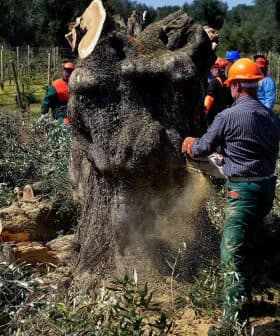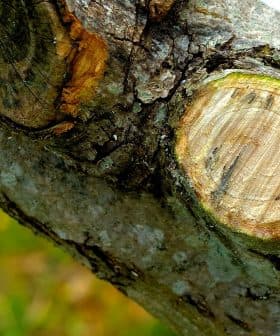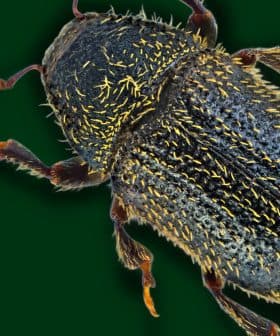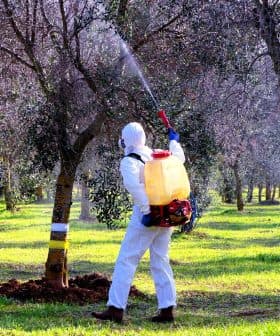Researchers Chart Pest Sightings in Effort to Protect Against Xylella
Using data collected from across the United Kingdom, scientists are creating a comprehensive record of where Xylella-carrying pests are found.
 Spittlebug
SpittlebugScientists in the United Kingdom are working on a project called BRIGIT to track the distribution of spittlebugs, which spread Xylella fastidiosa, a bacterium that has destroyed olive groves in Italy and the Mediterranean. The project, led by postdoctoral research fellow Claire Harkin at the University of Sussex, aims to understand how spittlebugs move and feed in order to predict and prevent the potential spread of Xylella in the U.K.
As a preventative measure against Xylella fastidiosa, scientists in the United Kingdom called on volunteers earlier this year to record sightings of spittlebugs and their residue. The researchers are using this data to chart their distribution across the U.K.
Spittlebugs, also known as xylem-feeding insects, spread Xylella – which has destroyed scores of olive groves across Italy and the Mediterranean region – from one infected plant to another when feeding on them.
If we can understand how far and how fast individual bugs move, what they prefer to feed on, and how much their populations mix, we can better predict how far and how fast Xylella might spread if it enters the U.K.
Spittlebugs are easy to identify by the frothy spittle they produce while feeding.
The U.K. research team consists of a consortium of 12 organizations, including the Royal Horticultural Society and the U.K.-based Universities of East Anglia, St Andrews, Salford, Stirling and Sussex. Known as BRIGIT, the project involves scientists in the fields of entomology, plant pathology, ecology, epidemiology, molecular biology, genomics and social science.
See Also:Xylella fastidiosa NewsClaire Harkin, a postdoctoral research fellow at the University of Sussex and member of the BRIGIT consortium, told Olive Oil Times that understanding the nature of spittlebugs is critical to managing the potential for a Xylella outbreak.
“If we can understand how far and how fast individual bugs move, what they prefer to feed on, and how much their populations mix, we can better predict how far and how fast Xylella might spread if it enters the U.K., and therefore be better prepared to more effectively respond should it arrive here,” she said.
Harkin said this is an ongoing project.
“Although we are coming to the end of the spittlebug season now, we will be running the spittle survey in some form again next year,” she said.
Alan Stewart, another member of the BRIGIT consortium and an ecology researcher at the University of Sussex, said one of their tasks for the winter months will be to decide how best to do this and which information gaps need to be filled.
Stewart said if Xylella-infected plants were imported to the U.K., there is potential for the bacterium to establish and spread across the country, “with potentially devastating consequences.”
He said as most research on Xylella and its insect carriers have been done in warmer climates, not much is known about how the pathogen may spread in Northern Europe.
Stewart appeared on BBC Breakfast, BBC Radio 4 and BBC Online to launch the project.
Harkin – who described the response to the project as “incredible” – said it remained the top online story on the BBC News Science and Environment pages for one week, with around 1.25 million views. In addition, BRIGIT called for volunteers in print publications.
“This generated a staggering public response, with over 1,000 records submitted on the first day alone,” she said. “We have now received over 14,000 records, over 80 percent of which include the crucial host plant information.”
Harkin said 400 species of host plants have been reported, and the top three are lavender, rose and rosemary. She said they have had some records submitted on olive trees, although “only a very small number.”
She added that they need to check and verify these records for the coming weeks.
“This is where the submission of photographs to support records has been enormously helpful,” she said. “Around 40 percent of submissions have associated photographs, which will make the verification task for these records much easier. Once we have verified the records, the interesting and important job of analyzing the data will begin – data that will feed into the wider BRIGIT research project to help.”
“We also know that around 80 percent of records have been submitted from private gardens,” Harkin added. “This is one of the huge benefits of running a citizen science campaign; we simply could not have accessed such data in any other way. We are enormously grateful to everyone… who has contributed data to this critically important area of research.”
Harkin said while Xylella is not currently thought to be present in the U.K., the insects that have been shown to be carriers in Mediterranean countries are common and widespread in the U.K. as well.
“Principal amongst these is the so-called common froghopper or meadow spittlebug – Philaenus spumarius,” Harkin said, “which is one of our most common insects. Ironically, it is also one of the most polyphagous, being known to feed on at least 400 different plant species.”
“The reason Xylella has spread so widely and over such long distances in recent years is because of humans moving infected plants and plant material,” Harkin added. “For example, through trade and by people bringing plants back with them from holidays abroad. This is the basis of the U.K. government’s “Don’t Risk It’ campaign.”
In a bid to prevent Xylella from spreading to the U.K, the government has spent more than £4.5 million ($5.59 million) to strengthen their border security.
“Whilst the bacteria are transmitted between plants by the xylem-feeding insects, we believe the insects themselves only travel relatively short distances — perhaps up to 100 meters by hopping or flying, but possibly further if they are carried on the wind,” Harkin said. “This is something we are looking to definitively answer through the BRIGIT research project.”









